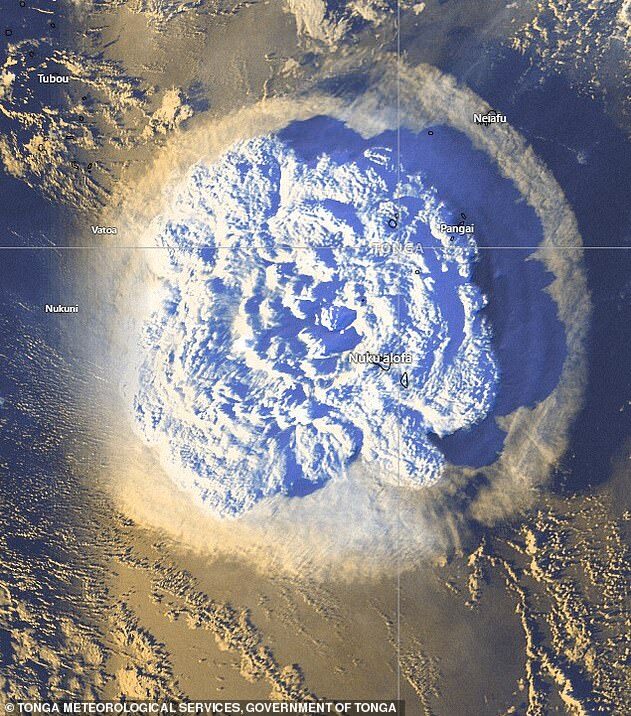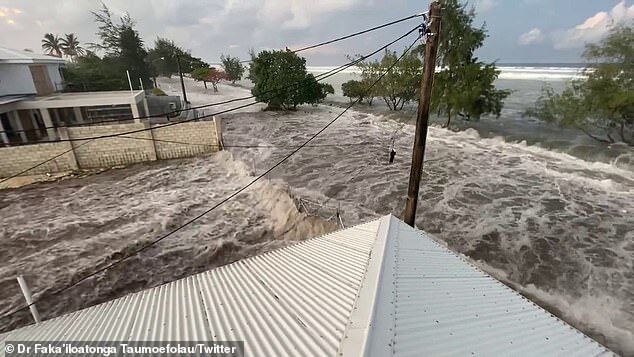
The Bureau of Meteorology issued an urgent alert that dangerous waves will start to affect Australia from 9.45pm on Saturday.
A tsunami struck Tonga sending terrified residents fleeing for their lives as surging waves crashed into homes and volcanic ash rained down from the sky.
Locals were warned to get out of the water and move to higher ground from as far away as Fiji as homes in the small South Pacific nation were swept away by the rising torrent.
Comment: Note how there's a lightning strike at 0:27, just as another vent erupts. This is due to an electric charge differential between the ash cloud, which is eruption debris that is now higher up in the atmosphere, and the freshly erupted material, which has just burst forth from inside the planet!
Australia joined Tonga, New Zealand, Fiji and American Samoa in issuing tsunami warnings after the 'violent' eruption of the Hunga-Tonga-Hunga-Ha'apai volcano, 30km from the Tongan archipelago.
The Australian warning was for a vast stretch of coastline from southern Queensland to Tasmania with the threat to the mainland centred around waterways where coastal flooding could occur.
But BoM said evacuations on the Australian mainland are 'not necessary'.

Several Australian offshore territories are under a more serious threat, including Lord Howe Island, Norfolk Island and Macquarie Island.
They are facing 'land warnings' meaning residents are advised to get 1km away from the coast.'
'People in land warning zones are strongly advised to move 1 kilometre inland or go to high ground at least 10 metres above sea level,' a BoM statement read.
On the Australian mainland people are advised to not enter the water.
A 'violent' underwater volcanic eruption at 5.10pm local time on Saturday was confirmed as the cause of the tsunami, which overwhelmed homes, buildings, fences, roads and cars in Tonga around 20 minutes afterwards.
Locals pleaded for people to 'pray for us' as the eruption was compared to 'bombs going off', followed by the tsunami surging ashore.
One lucky survivor recounted the horror of watching her neighbours house collapse as she was sitting down with his family for dinner.
Another man revealed how he desperately fled the rising torrent while carrying his grandmother to the roof of their home.
The volcano could be heard thousands of kilometres away and sparked warnings in New Zealand, Fiji and American Samoa.
Dramatic footage showed huge waves surging ashore on the populated islands of the Tongan archipelago hours after the eruption.
The Tongan Meteorological Service issued the tsunami warning for the main island of Tongatapu on Saturday evening as sirens rang out across the capital, Nukuʻalofa.
There were also reports of volcanic ash falling in Nukuʻalofa.
Local woman Mere Taufa was preparing for dinner for her family when the biggest eruption shook her home.
'It was massive, the ground shook, our house was shaking. It came in waves, my younger brother thought bombs were exploding nearby,' Taufa told stuff.co.nz.
She said the home quickly filled with water and she saw the walls of a neighbour's home get washed away.
'You could just hear screams everywhere, people screaming for safety, for everyone to get to higher grounds.'
Another man made a narrow escape by carrying his to the roof grandmother to the roof of their Nuku'alofa home.
Tevita Sailosi said they were in shock when they heard the explosion.
'We've heard screaming, people have helped where they could. We've also heard some singing too, so that's lifted our spirits a bit. We just hope everyone else is safe out there,' he said.
As the initial danger subsides, there are now serious humanitarian concerns as shelters set up to house displaced residents 'run out of food'.
A person who watched the New Zealand High Commission complex go underwater said a young boy showed up soaking not knowing what happened to his family after he fled the tsunami.
Emergency warnings in Tonga ordered locals to move urgently to higher ground.
The Hunga-Tonga-Hunga-Ha'apai volcano erupted on Friday sending debris, ash and gas 20 kilometres into the air.
The eruption plunged the nation's main islands into darkness on Friday.
But the chaos on Saturday came from a second much larger eruption.
It is located about 30 kilometres south-east of Fonuafo'ou island in Tonga and has erupted several times in recent weeks.
The eruption also led to tsunami warnings for Fiji and American Samoa, which are 804 and 936 kilometres away from Tonga.
In Fiji the Mineral Resources Department warned people to 'stay out of the water and away from beaches'.
One man wrote on social media, 'We live in Kolomotu'a near the ocean so we have left already and we are in our cars heading out but traffic on every road.'
'Please pray for us as a family and safety.'
An American stormwatchers group called the footage, which quickly went viral online, 'one of the most violent volcano eruptions ever captured on satellite'.



Comment: Spaceweather.com further reports: Here's footage showing the eruption's global shockwave: